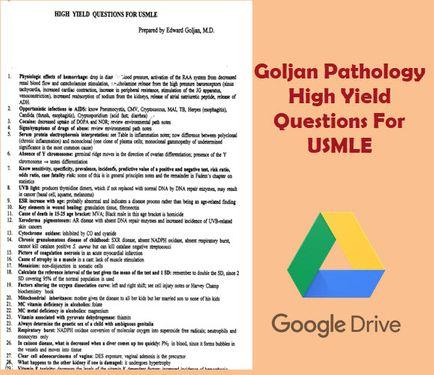Goljan Pathology High Yield Questions For USMLE

Goljan Pathology High Yield Questions For USMLE Step 1
These are high yield questions prepared by Edward Goljan, they focus on the most important notes that may present in your step 1 exam.
GOLJAN resources are very important resource to prepare for USMLE step 1 2018 ,they will help you to master and review all of the pathology .
There are many materials published by goljan which include:
1-goljan audio lectures (goljan pathology audio)
2-goljan rapid review pathology
3-Rapid Review Pathology
4-Rapid Review Pathology With STUDENT
Please be kind and support this website by 1 , 3 or 5 $$
[sociallocker]Files Size:: 3.1 MB
[/sociallocker]Sample From the book::
High Yield Questions For USMLE
Prepared by Edward Goljan, M.D.
Physiologic effects of hemorrhage: drop in diast v : ‘>iood pressure, activation of die RAA system from decreased renal blood flow and catecholamine stimulation, v .’i’�holamine release from the high pressure baroreceptors (sinus tachycardia, increased cardiac contraction, increase in peripheral resistance, stimulation of the JG apparatus, venoconstriction), increased reabsoiption of sodium from &e kidneys, release of atrial natriuretic peptide, release of ADH.
Opportunistic infections in AIDS: know Pneumocystis, CMV, Cryptococcus, MAI, TB, Herpes (esophagitis), Candida (thrush, esophagitis), Cryptosporidium (acid fest; diarrhea)
Cocaine: decreased uptake of DOPA and NOR; review environmental path notes Signs/symptoms of drugs of abuse: review environmental path notes
Serum protein electrophoresis interpretation: see Table in inflammation notes; now difference between polyclonal (chronic inflammation) and monoclonal (one clone of plasma cells; rntmoclonal gammopathy of undetermined
significance is the most common cause)
Absence of Y chromosome: germinal ridge moves in the direction of ovarian differentiation; presence of the Y chromosome testes differentiation
Know sensitivity, specificity, prevalence, incidenife, predictive value of a positive and negative test, risk ratio, odds ratio, case fatality risk: some of this is in general principles notes and the remainder in Fadem’s chapter on statistics
UVB light: produces thjmiidine dimers, which if not replaced with normal DNA by DNA repair enzymes, may result in cancer (ba� cell, squame, melanoma)
ESR increase with age: probably abnormal and indicates a disease process rather than being an age-related finding Key elements in wound healing: granulation tissue, fibronectin
Cause of death in 15-25 age bracket: MV A; Black male in this age bracket is homicide
Xeroderma pigmentosum: AR disease with absent DNA repair enzymes and increased incidence of UVB-related
skin cancers
Cytochrome oxidase: inhibited by CO and cyanide
Chronic granulomatous disease of childhood: SXR disease, absent NADPH oxidase, absent respiratory burst, cannot kill catalase positive S. aureus but can kill catalase negative streptococci Picture of coagulation necrosis in an acute myocardial infarction Cause of atrophy in a muscle in a cast: lack of muscle stimulation
Mosaicism: non-disjunction in somatic cells
Calculate the reference interval of the test given the mean of the test and 1 SD: remember to double the SD, since 2 SD covering 95% of the normal population is used
Factors altering the oxygen dissociation curve: left and right shift; see cell injury notes or Harvey Champ
biochemistry book
Mitochondrial inheritance: mother gives the disease to all her kids but her married son to none of his kids MC vitamin deficiency in alcoholics: folate MC metal deficiency in alcoholics: magnesium
Vitamin associated with pyruvate dehydrogenase: thiamin
Always determine the genetic sex of a child with ambiguous genitalia
Respiratory burst: NADPH oxidase conversion of molecular oxygen into superoxide free radicals; neutrophils and monocytes only



![8 Months USMLE Step 1 Experience 2023 Score [PASS].](https://medbooksvn.org/wp-content/uploads/2023/05/8-Months-USMLE-Step-1-Experience-Score-PASS-280x210.png)
Leave a Reply